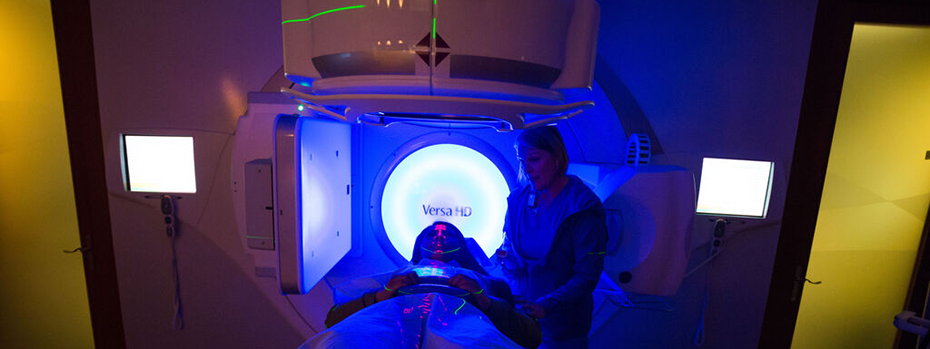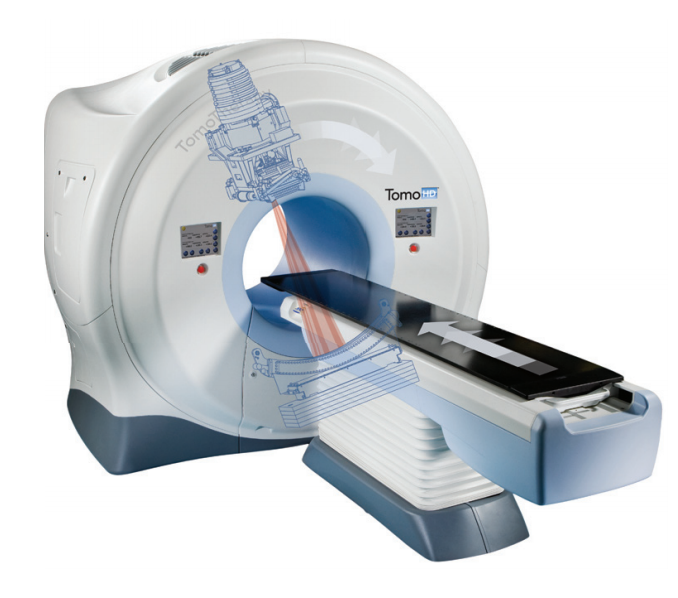External Beam Radiation Therapy

External beam radiation therapy uses rays of energy to kill cancer cells. At the OHSU Knight Cancer Institute, we offer:
- Expert radiation doctors who are part of your care team.
- Leading-edge technology.
- The latest techniques to pinpoint cancer and reduce side effects.
What is external beam radiation therapy?
External beam radiation attacks cancer with high-powered beams of energy, such as X-rays. It uses a machine called a linear accelerator to send energy beams through the skin and into the body. While you lie on a table, the accelerator moves around you, aiming radiation at the tumor from different angles. Like spotlights that converge on an actor onstage, this technique pinpoints the cancer and reduces exposure to healthy tissue.
Schedule: Treatment usually lasts five days a week for several weeks. This allows your team to deliver enough radiation to kill cancer cells while giving your body time to recover.
Types and procedures
There are several types of radiation therapy. The one you get depend on your overall health and the type and stage of your cancer. Your team will recommend a treatment plan tailored to your needs.
What is it? 3D CRT uses computer-assisted scans to pinpoint the size, shape and location of your tumor and surrounding organs. This helps your doctor tailor radiation beams to the shape of the tumor. Because the shaped beam is so precise, we can deliver a higher dose of radiation without harming healthy cells.
How is it delivered? Most patients receive 3D CRT five days a week for several weeks. Your radiation oncologist will make a mold or cast of the body part being treated. This serves as a shield and helps you stay still so radiation targets the tumor and avoids healthy tissue. It helps destroy more cancer cells with each treatment and allows you to recover more quickly.
What cancers is it used for?
- Breast cancer
- Children’s cancers
- Cancers that have traveled to the brain or bone
What is it? IMRT is a specialized type of 3D conformal radiation therapy that breaks the radiation into many beams to “paint” treatment in three dimensions. The tumor is first mapped in 3D using CT (computed tomography) or MRI (magnetic resonance imaging). Then computers calculate and vary radiation doses from different angles. It allows your doctor to more precisely match the shape of the tumor and vary radiation to different parts of the tumor. This precise control can lessen side effects.
How is it delivered? Most patients receive IMRT five days a week for several weeks. Because of the many angles used to deliver radiation, each session may take as long as an hour.
What cancers is it used for?
What is it? IGRT is a type of intensity-modulated radiation therapy that uses scans during therapy to better target cancer cells. This is important because moving or breathing can change a tumor’s position. IGRT allows the doctor to make sure that the treatment is delivered to where the cancer is each day. It uses scans such as ultrasounds, X-rays, MRI, PET or CT scans for planning and just before a treatment session.
How is it delivered? Most patients have IGRT once a day five days a week. During treatment, you will have a series of scans. Your doctor will analyze the scans by computer to find any changes in the tumor’s position or size. Your doctor will then adjust the dose or location to target cancer cells and avoid healthy tissue.
If you have prostate cancer, you may receive IGRT using the state-of-the-art Calypso system. Calypso lets us continuously monitor your tumor with tiny sensors placed inside the prostate gland. We can focus radiation on the tumor and spare healthy areas.
What cancers is it used for?
What is it? Most radiation therapy uses beams of photons. Proton therapy uses beams of protons.
Protons are subatomic particles that release all their energy in a sudden burst. This allows the doctor to reduce the amount of healthy tissue that receives radiation.
How is it delivered? A machine speeds up the protons, then sends proton beams through the skin to your tumor. The beams conform to the shape and depth of the tumor.
Oregon currently has no proton therapy center. However, we can help you decide if this treatment is right for you. If you choose to go ahead, we can refer you to a center that offers it.
What is it used for? Proton therapy is most effective for childhood tumors and for tumors that are near important body parts such as the eyes, brain or spinal cord.
What is it? A way to deliver a powerful dose of radiation to a small area of the brain using advanced technology. Unlike other surgery, no incision is made and no tissue is surgically removed.
How is it delivered? A neurosurgeon fits you with a head frame. The frame helps doctors aim the radiation precisely at your tumor. You get a CT scan, lie on a bed and wear a special helmet. The accelerator aims as many as 200 beams of energy at your tumor. You will not see or feel anything during treatment. This is an outpatient procedure, but it takes a full day in the clinic.
Why choose it?
- Fewer complications than conventional surgery.
- Can be completed in a single visit.
- Most patients are back on their feet the next day.
What technology do we use?
- Gamma Knife
- TrueBeam
What cancers is it used for?
What is it? A way to aim beams of energy at tumors in your body using advanced technology. We use the sophisticated Novalis Tx system, ensuring that you get the optimum dose while sparing healthy tissue
How is it delivered? Patients usually have up to five sessions, one a day. Most sessions take a few minutes to an hour.
The Novalis Tx machine rotates around you, adjusting to your movements. The imaging system makes sure radiation focuses on the tumor. Because we can aim more radiation at the tumor, you need fewer sessions than with other treatments.
What cancers is it used for?
- Head and neck cancer
- Lung cancer
- Liver cancer
- Pancreatic cancer
- Previously treated cancers

What is it? TomoTherapy combines CT and external beam technology in one machine. Your doctors can adjust your treatment as they go based on even the smallest anatomy changes.
How is it delivered? Most patients receive TomoTherapy in a daily visit five days a week. Each session lasts 10 to 20 minutes. The machine is shaped like a doughnut, and you lie on a bed in its center. It scans your tumor, then rotates around you to aim radiation precisely where you need it.
What cancers is it used for?
What is it? Also called total body radiation therapy, this treatment uses a low dose of radiation to kill cancer cells throughout your body. Because this radiation travels through your entire system, TBI may be used to treat blood disorders or blood cancers. If your treatment plan includes a bone marrow or stem cell transplant, you might have TBI first. This helps keep your immune system from harming the transplanted healthy cells.
How is it delivered? The machine is shaped like a doughnut, and you lie on a bed in its center. Your lungs and kidneys may be covered with a shield to protect them from radiation. Depending on your cancer type and other factors, you might have several treatments or just one. Because you’ll receive a low dose, you might also have chemotherapy to help destroy cancer cells.
What cancers is it used for?
- Leukemia
- Lymphoma
- Multiple myeloma
- Other blood disorders
What is it? Unlike other forms of radiation, which use photons, this type uses electrons. Electrons are useful in treating skin cancer because most of the radiation is absorbed into the skin.
How is it delivered? TSEB is usually done over 18 or 36 treatments, Monday through Friday. Because the radiation is distributed over your entire skin, patients stand during treatment. OHSU uses the Stanford technique, in which you stand in three positions one day, then three different positions the next day. This allows the radiation to reach as much of your skin as possible.
What cancers is it used for? Skin lymphoma
What is it? Also called alternating electric field therapy, TTFields fights cancer with mild electrical fields instead of radioactive beams. A wearable device sends electrical pulses through the skin in your scalp. These pulses disrupt cancer cells’ ability to reproduce. When cancer cells can’t grow, they die. TTFields does not affect normal cells. The Knight has successfully used TTFields to treat patients with mesothelioma and brain cancer.
How is it delivered? Patients wear a portable, battery-operated device for most of the day. Shaped like a close-fitting cap, the device sends alternating electric fields to the tumor. TTFields can be delivered at home. Patients usually check in with their care team every month or two to monitor effectiveness.
What cancers is it used for?
- Glioblastoma, a cancer that affects the brain and spinal cord.
- Mesothelioma, a cancer that affects the chest or abdomen.
Learn more
- External Beam Radiation Therapy for Cancer, National Cancer Institute
- External Beam Radiation Therapy, American Cancer Society
- Treatment Types: External Beam Radiation Therapy, RT Answers, American Society for Radiation Oncology
- Proton Therapy, Cancer.Net, American Society of Clinical Oncology
For patients
- Request an appointment at our Marquam Hill location: 503-494-8756
- Request an appointment at our Beaverton location: 971-262-9400
Visit our For Cancer Patients page to find a cancer doctor and links to diagnoses.
Locations
OHSU Knight Cancer Institute Radiation Medicine, Marquam Hill
Kohler Pavilion, fourth floor
808 S.W. Campus Drive
Portland, OR 97239
OHSU Knight Cancer Institute, Beaverton
15700 S.W. Greystone Court
Beaverton, OR 97006
CMH-OHSU Knight Cancer Collaborative, Astoria
1905 Exchange Street
Astoria, OR 97103
OHSU Radiation Oncology at Roseburg Community Cancer Center
2880 N.W. Stewart Pkwy, #100
Roseburg, OR 97471
Free parking for patients and visitors
Refer a patient
- Refer your patient to OHSU.
- Call 503-494-4567 to seek provider-to-provider advice.
Read more
Learn more about OHSU Knight Cancer Institute treatments: